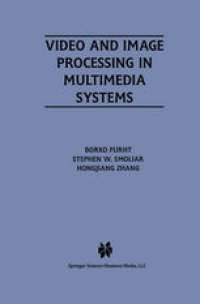
Ebook: Video and Image Processing in Multimedia Systems
- Tags: Electrical Engineering, Signal Image and Speech Processing, Data Structures Cryptology and Information Theory, Computer Science general
- Series: The Springer International Series in Engineering and Computer Science 326
- Year: 1995
- Publisher: Springer US
- Edition: 1
- Language: English
- pdf
Video and Image Processing in Multimedia Systems treats a number of critical topics in multimedia systems, with respect to image and video processing techniques and their implementations. These techniques include:
- Image and video compression techniques and standards, and
- Image and video indexing and retrieval techniques.
This book serves as an invaluable reference with respect to the most important standards in the field. Video and Image Processing inMultimedia Systems is suitable as a textbook for course use.
Video and Image Processing in Multimedia Systems treats a number of critical topics in multimedia systems, with respect to image and video processing techniques and their implementations. These techniques include:
- Image and video compression techniques and standards, and
- Image and video indexing and retrieval techniques.
This book serves as an invaluable reference with respect to the most important standards in the field. Video and Image Processing inMultimedia Systems is suitable as a textbook for course use.
Video and Image Processing in Multimedia Systems treats a number of critical topics in multimedia systems, with respect to image and video processing techniques and their implementations. These techniques include:
- Image and video compression techniques and standards, and
- Image and video indexing and retrieval techniques.
This book serves as an invaluable reference with respect to the most important standards in the field. Video and Image Processing inMultimedia Systems is suitable as a textbook for course use.
Content:
Front Matter....Pages i-xii
Front Matter....Pages 1-1
Basic Concepts....Pages 3-32
Multimedia Networking and Synchronization....Pages 33-57
Overview of Multimedia Applications....Pages 59-89
Front Matter....Pages 91-91
Introduction to Multimedia Compression....Pages 93-102
JPEG Algorithm for Full-Color Still Image Compression....Pages 103-133
Px64 Compression Algorithm for Video Telecommunications....Pages 135-141
MPEG Compression for Motion-Intensive Applications....Pages 143-167
Other Multimedia Compression Techniques....Pages 169-184
Implementations of Compression Algorithms....Pages 185-204
Applications of Compression Systems....Pages 205-222
Front Matter....Pages 223-223
Content-Based Image Retrieval....Pages 225-270
Content-Based Video Indexing and Retrieval....Pages 271-321
Video Processing Using Compressed Data....Pages 323-334
A Case Study in Video Parsing: Television News....Pages 335-369
Back Matter....Pages 371-377
Video and Image Processing in Multimedia Systems treats a number of critical topics in multimedia systems, with respect to image and video processing techniques and their implementations. These techniques include:
- Image and video compression techniques and standards, and
- Image and video indexing and retrieval techniques.
This book serves as an invaluable reference with respect to the most important standards in the field. Video and Image Processing inMultimedia Systems is suitable as a textbook for course use.
Content:
Front Matter....Pages i-xii
Front Matter....Pages 1-1
Basic Concepts....Pages 3-32
Multimedia Networking and Synchronization....Pages 33-57
Overview of Multimedia Applications....Pages 59-89
Front Matter....Pages 91-91
Introduction to Multimedia Compression....Pages 93-102
JPEG Algorithm for Full-Color Still Image Compression....Pages 103-133
Px64 Compression Algorithm for Video Telecommunications....Pages 135-141
MPEG Compression for Motion-Intensive Applications....Pages 143-167
Other Multimedia Compression Techniques....Pages 169-184
Implementations of Compression Algorithms....Pages 185-204
Applications of Compression Systems....Pages 205-222
Front Matter....Pages 223-223
Content-Based Image Retrieval....Pages 225-270
Content-Based Video Indexing and Retrieval....Pages 271-321
Video Processing Using Compressed Data....Pages 323-334
A Case Study in Video Parsing: Television News....Pages 335-369
Back Matter....Pages 371-377
....
Download the book Video and Image Processing in Multimedia Systems for free or read online
Continue reading on any device:

Last viewed books
Related books
{related-news}
Comments (0)